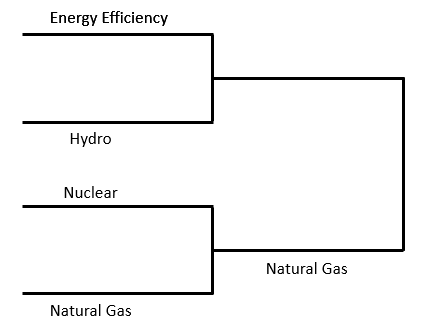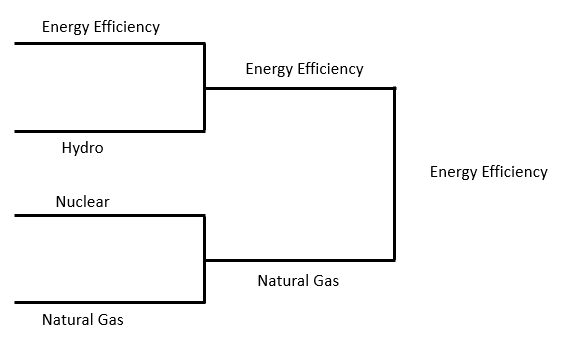Who is the real Rodney Dangerfield of energy? Part two

The last post left off with a real cliffhanger about which energy source has the most valid claim to be the coveted Rodney Dangerfield of energy. The claim is based on maybe the most famous of Rodney’s one-liners—that different energy sources for generating electricity claim, like the man, to “get no respect.” The previous post used the energy policy criteria of cheap, clean and reliable to show that natural gas ousted nuclear largely because it is overwhelmingly less expensive ($/W installed). Today’s match-up for a shot at respect is between energy efficiency and hydropower and subsequently, the real Rodney Dangerfield of Energy will be crowned.
Energy efficiency
Perhaps the original claim to “no respect” comes from energy efficiency. This claim is closely related to the fact that the energy source is hard to visualize and difficult to get excited about because it’s mostly invisible. If there were an Apollo-type project to combat climate change, it would be hard to get people to rally around the message if energy efficiency were the flag bearer. Energy efficiency doesn’t really carry a flag the way a giant solar installation, a nuclear reactor, or wind turbine can. Oftentimes there is nothing to see. So, does it deserve more respect? Dr. James Sweeney makes the case for respect here1 that the decreasing the energy intensity (CO2e/$GDP) of the U.S. economy in recent decades is due in large part to energy efficiency. Renewables and nuclear have impacted this trend much less significantly. The downside of scaling energy efficiency is that program subsidies are often imperfectly calibrated to deliver benefits at least cost so they have a chance to be much better. Perhaps the biggest problem for energy efficiency is that more energy isn’t being economically unconsumed. In short, consuming less of any energy source is almost always cleaner than the status quo and practically none of the constraints which may limit the construction of new electrical generation (permitting, siting, transmission, etc.) will be applicable to energy efficiency. On price, it continues to be cost-competitive with generation in the U.S. So, it’s cheap, clean, and reliable and still claims to “get no respect.”
Hydro
Hydro-electric power is the original zero emissions electricity source. When Thomas Edison set up the world's first commercial electric utility in 1882, a private hydroelectric plant at Niagara Falls had already been running for three years. Until the late 1980s, when wind and solar electricity production started coming online, hydro power constituted over 90% of total renewable power production, and until the mid-1980s provided a greater share of the nation's power than nuclear plants. The reasons for this popularity, and what makes hydro a contender for “more respect,” are the lack of emissions (like wind, solar, and nuclear), along with predictability (like nuclear and other thermal sources), but with a dispatchability second only to natural gas (within seasonal constraints).
But alas, there's also bad news -- the dams which are built to facilitate hydroelectric power generation contribute to ecosystem destruction, loss of arable land, downstream water shortages, methane emissions from the decay of trees and plants in flooded reservoirs and forced relocation of local communities. A recent example is the Three Gorges Dam in China, currently the world's largest. The New York Times reports that the dam's construction has resulted in 1.4 million people being displaced, and may even have been responsible for triggering a 2008 earthquake resulting in 87,000 deaths. Not clean.
Considering these concerns, many dams are starting to be removed around the world. The BBC reports that in the U.S. and Europe in the last several years, dams are being removed at a greater pace than new installations.
But is it cheap? Washington state has most hydro power of any U.S. state and has the lowest electrical rates largely because of the Grand Coulee Dam. Hydro is cheap and if their physical and political supports remain intact, it is also reliable. Cheap and reliable but not so clean.
Rodney-Dangerfield-Final-Four-of-no-respect-in-energy (RDFFONRIE): Part Two Hydro has reliably been a source of low emissions electrical energy but cannot claim to be as clean as energy efficiency. Hydro has been and continues to be cheap and for the time being, reliable. But with challenges for future dams, the prospects for hydro are not growing. The reliability and clean tallies skew toward energy efficiency. Energy efficiency moves on.

Energy Efficiency vs. Natural Gas
A common metric for comparing energy sources over their lifetimes is the levelized cost of energy (LCOE). Projecting LCOE of new capacity does not account for future energy efficiency gains which may result in an overestimate plant revenue. Comparing cost of energy efficiency programs with cost of new construction, energy efficiency is already comparable or cheaper without considering a “penalty” for overestimates of generation in LCOE. It is undoubtedly cleaner. But is it reliable? Natural gas is mostly home “grown” due to the fracking revolution and it looks to have at least 100 years of supply; the supply is reliable and dispatchable. However, if natural gas will be burned for the next hundred years energy efficiency will just as reliably be there to decrease its demand. Scorecard: energy efficiency may already be cheaper, is cleaner, and is as reliable as the existence of natural gas for electrical generation.

Congratulations, energy efficiency! Your claim to the crown is alive, well and appears reasonable. So, how should we make energy efficiency as a policy priority the recipient of the respect it deserves?
P.S. If you feel any of our assumptions or conclusions deserve “no respect” please sound off in the comments section.
1If you do watch this, note that in the 41st minute Dr. Sweeney describes his book as having a title “almost as boring as watching a light bulb get more efficient!” The “no respect” complex in energy efficiency is deep indeed.